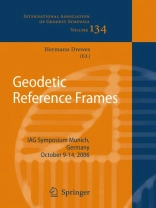Geodetic reference frames are the basis for The programme of the Symposium was divided three-dimensional, time dependent positioning according to the Sub-commissions, Projects in all global, regional and national networks, in and Study Groups of Commission 1 into eight cadastre, engineering, precise navigation, geo- general themes: information systems, geodynamics, sea level studies, and other geosciences. They are 1. Combination of space techniques necessary to consistently estimate unknown 2. Global reference frames and Earth rotation parameters using geodetic observations, e. g. , 3. Regional reference frames station coordinates, Earth orientation and 4. Interaction of terrestrial and celestial frames rotation parameters. Commission 1 “Reference 5. Vertical reference frames Frames” of the International Association of 6. Ionosphere modelling and analysis Geodesy (IAG) was established within the new 7. Satellite altimetry structure of IAG in 2003 with the mission to 8. Use of GNSS for reference frames study the fundamental scientific problems for the establishment of reference frames. One day of the Symposium was dedicated to a The principal objective of the scientific work joint meeting with the International Congress of the Commission is basic research on: of Federación Internationale des Géomètres – Definition, establishment, maintenance, and (FIG) and the INTERGEO congress of the improvement of geodetic reference frames. German Association of Surveying, Geo- – Advanced development of terrestrial and information and Land Management. The space observation techniques for this contributions presented at this meeting are purpose. integrated into these proceedings.
Table of Content
Combination of Space Techniques (Convenor: M. Rothacher).- Combination of Earth Orientation Parameters and Terrestrial Frame at the Observation Level.- DGFI Combination Methodology for ITRF2005 Computation.- Combining One Year of Homogeneously Processed GPS, VLBI and SLR Data.- Inverse Model Approach for vertical Load Deformations in Consideration of Crustal Inhomogeneities.- Station Coordinates and Low Degree Harmonics with Daily Resolution from a GPS/CHAMP Integrated Solution and with Weekly Resolution from a LAGEOS-only Solution.- Rigorous Variance Component Estimation in Weekly Intra-Technique and Inter-Technique Combination for Global Terrestrial Reference Frames.- Assessment of the Results of VLBI Intra-Technique Combination Using Regularization Methods.- Global Reference Frames (Convenor: C. Boucher).- Contribution of Lunar Laser Ranging to Realise Geodetic Reference Systems.- Vienna VLBI Simulations.- Towards an Improved Assessment of the Quality of Terrestrial Reference Frames.- Strengthes and Limitations of the ITRF: ITRF2005 and Beyond.- The International Terrestrial Reference Frame (ITRF2005).- Effects of Different Antenna Phase Center Models on GPS-Derived Reference Frames.- Influence of Time Variable Effects in Station Positions on the Terrestrial Reference Frame.- The Actual Plate Kinematic and Crustal Deformation Model APKIM2005 as Basis for a Non-Rotating ITRF.- Control Measurements Between the Geodetic Observation Sites at Mets#x00E4;hovi.- VLBI-GPS Eccentricity Vectors at Medicina#x0027;s Observatory GPS Surveys: Reproducibility, Reliability and Quality Assessment of the Results.- Regional Reference Frames (Convenor: Z. Altamimi).- The Practical Implications and Limitations of the Introduction of a Semi-Dynamic Datum #x2013; A New Zealand Case Study.- Evaluation of Analysis Options for GLONASS Observations in Regional GNSS Networks.- The European Reference Frame: Maintenance and Products.- The EUREF Permanent Network: Monitoring and On-line Resources.- Noise and Periodic Terms in the EPN Time Series.- Long-Term Densification of Terrestrial Reference Frame in Central Europe as the Result of Central Europe Regional Geodynamic Project 1994-2006.- A First Estimate of the Transformation Between the Global IGS and the Italian ETRF89-IGM95 Reference Frames for the Italian Peninsula.- Achievements and Challenges of SIRGAS.- The Position and Velocity Solution DGF06P01 for SIRGAS.- Using an Artificial Neural Network to Transformation of Coordinates from PSAD56 to SIRGAS95.- CPLat: the Pilot Processing Center for SIRGAS in Argentine.- Realization of the SIRGAS Reference Frame in Colombia.- Seasonal Position Variations and Regional Reference Frame Realization.- IGS/EPN Reference Frame Realization in Local GPS Networks.- Systematical Analysis of the Transformation Between Gauss-Krueger-Coordinate/DHDN and UTM-Coordinate/ETRS89 in Baden-W#x00FC;rttemberg with Different Estimation Methods.- Empirical Affine Reference Frame Transformations by Weighted Multivariate TLS Adjustment.- Modified Sidereal Filtering #x2013; Tool for the Analysis of High-Rate GPS Coordinate Time Series.- Questioning the Need of Regional Reference Frames.- Interaction of Terrestrial and Celestial Frames (Convenor: H. Schuh).- Empirical Earth Rotation Model: a Consistent Way to Evaluate Earth Orientation Parameters.- A Quasi-Optimal, Consistent Approach for Combination of UT1 and LOD.- The Effect of Meteorological Input Data on the VLBI Reference Frames.- Estimation of UT1 Variations from Atmospheric Pressure Data.- Various Definitions of the Ecliptic.-The Combined Solution C04 for Earth Orientation Parameters Consistent with International Terrestrial Reference Frame 2005.- Vertical Reference Frames (Convenor: J. Ihde).- Strategy to Establish a Global Vertical Reference System.- GPS Gravity-potential Leveling.- The Role of the TIGA Project in the Unification of Classical Height Systems.- Challenges and First Results Towards the Realization of a Consistent Height System in Brazil.- The New Finnish Height Reference N2000.- Heights in the Bavarian Alps: Mutual Validation of GPS, Levelling, Gravimetric and Astrogeodetic Quasigeoids.- Atmosphere Modelling and Analysis (Convenor: M. Schmidt).- Residual Analysis of Global Ionospheric Maps Using Modip Latitude.- Neutral Atmosphere Delays: Empirical Models Versus Discrete Time Series from Numerical Weather Models.
Language English ● Format PDF ● Pages 324 ● ISBN 9783642008603 ● File size 46.8 MB ● Editor Hermann Drewes ● Publisher Springer Berlin ● City Heidelberg ● Country DE ● Published 2009 ● Downloadable 24 months ● Currency EUR ● ID 2170319 ● Copy protection Social DRM












